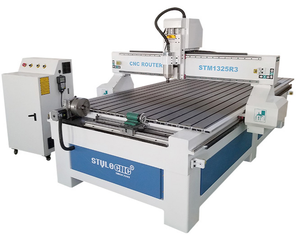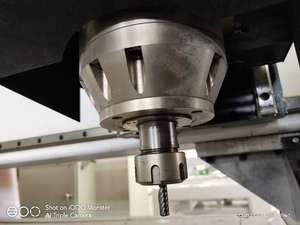(76 products available)






























































































































































































A CNC router machine comes in different types, each with distinctive features. The following are some of them:
CNC Wood Router:
A CNC wood router employs computer-driven technology to cut and shape wood products precisely. Its working area contains a vacuum pump mounting system to hold workpieces in place during the cutting process securely. The CNC wood router achieves accurate cuts, customizable designs, effortless creation of intricate patterns, and automated operation with minimal human intervention. CNC routers for wood typically come in different models. The routers can handle various sizes and thicknesses.
advertising CNC Router:
The advertising CNC router is designed for cutting and engraving materials typically used in advertising, such as foam, PVC, acrylic, and composite panels. This machine performs high-speed processing, allowing for the efficient production of signboards, displays, and promotional materials. The advertising CNC router achieves smooth and delicate cutting edges, satisfying the industry’s quality requirements. CNC routers for advertising typically have a large working table area. The table area is big enough to accommodate the machining of large-sized boards.
CNC Stone Router:
The CNC stone router is a professional machine used for stones like marble, granite, and quartzite. This type of router is suitable for stone machining because it offers strong and durable spindle motors. CNC routers for stone have dust collection systems that reduce the amount of debris and dust released into the air while working on stone materials. The stone CNC router achieves precise engraving, cutting, and shaping of stone materials, offering intricate design possibilities. The designs include but are not limited to sculptures, patterned flooring, and decorative elements.
CNC Metal Router:
A CNC metal router absorbs the characteristics of a metal CNC machining center. This machine is suitable for machining metal materials like aluminum, brass, copper, and alloys, among others. The available machine tools are usually customized according to the needs of different customers. The customization includes the choice of spindle power, feed rate, and other parameters. It also includes the selection of additional equipment and accessories, such as tool changers and automatic lubricating systems.
Spindle Power:
The spindle power of a CNC wood router 1280 determines the machine's cutting capacity and ability to handle different types of materials. A strong spindle can cut through thick woods, acrylics, and other materials without slowing down. This consistent performance helps the router create smooth, even cuts on high-quality wood.
Drive System:
The drive system of a CNC 1280 router controls how it moves during cutting. Different drive systems, like gear/rack, ball screw, or belt drive, offer varied movement precision and speed. Choosing the right drive system affects how accurately the router cuts wood and other materials.
Table Size:
The tabletop of a CNC router is where the material being cut is placed. The size of this table determines the biggest pieces the machine can cut. A router with a larger tabletop can work with bigger materials, making it versatile for various projects that involve large sheets as well.
Vacuum Pump:
A vacuum pump holds materials, like wood, firmly against the CNC router's work surface during cutting. This temporary suction helps keep pieces in place, ensuring consistent cutting results. Choosing the correct strength of the pump allows it to adequately grip materials of different sizes and thicknesses securely.
Dust Ekstractor:
A dust extractor cleans up sawdust and debris while the CNC router 1280 cuts. The routing process generates a lot of dust which can damage the router and work area. The extractor's job is to remove this waste, helping keep the machine and workspace tidy and free of obstructions from excess dust.
Regular maintenance is crucial for the proper performance and durability of the CNC router 1280. Here are some key router maintenance tips:
The versatile CNC router 1280 can be used in multiple industries for various applications. Some of them are as follows:
When choosing a CNC wood router machine, one with a good spindle should be prioritized. The spindle's size and speed impact the machine's cutting capacity and the material. A powerful router can easily cut through many types of wood, including hardwood. Additionally, the spindle speed determines the CNC router's ability to cut various materials, such as metal and plastic.
Consider how important it is for the CNC router to have a quiet operation. Machines with brushless spindles usually operate at lower noise levels. This means that even if the spindle of the router is big and powerful, its noise output will be minimal.
The working area basically tells users how much work the router can handle. A large working area means that the machine can handle a big board, which is great for projects that need to work with large materials. Users with small workspaces may need to get a machine with a smaller working space. In such situations, they may get a CNC router machine with a sideways design that can easily pass through doors and other entry areas.
CNC machines come with different user interfaces and controls. Some have advanced touch screen technology with 2D and 3D simulation capabilities, while others are simplistic and only support 2D controls. Because most customers prefer easy-to-use machines, those with a humanized operating system should be prioritized.
The machine's frame and rack are crucial for stable cutting and movement. The stability, accuracy and precision of cuts are determined by the frame and rack. Rigid material for the frame and durable, smooth rails will make the CNC router more accurate, efficient, and consistent in its cut.
The overall structure of the CNC router machine—flat bed, gantry, and tilt structure—also influences how suitable it will be for a particular purpose. This choice depends on the type of project one typically undertakes. If dealing with flat wooden boards, a flat-bed CNC router would be just fine. For those who typically work on large-scale projects with a high level of complexity, investing in the more advanced CNC router machines with a rub, gear, and rack transmission suited for large workpieces, may be worthwhile. This machine type has the ability to perform complicated tasks with a high degree of accuracy and precision.
Q1: What is the benefit of a CNC router?
A1: The primary benefit of a CNC router is that it offers automated cutting. An operator does not have to spend many hours manually guiding a cutting tool to achieve the desired cut. Other benefits include user-friendly software, flawless reproduction of designs, multi-axis operations, and the ability to cut a wide range of materials.
Q2: What is the difference between a CNC router and CNC plasma?
A2: A CNC router machine cuts materials using a rotating tool or bit. On the other hand, a CNC plasma machine uses a high-temperature plasma arc to cut metal. As such, the two machines are suitable for different materials and applications. A CNC router machine is ideal for cutting wood, plastic, and composite materials. A CNC plasma machine is preferable for metal materials like steel, aluminum, and copper.
Q3: Can a CNC router cut metal?
A3: Yes, a CNC router can cut metal. Though the machine primarily cuts soft materials like wood, plastic, and foam, certain alloys and metals with a low thickness can go through a CNC router. Metals like zinc, brass, and aluminum are easy for the router to cut through. Nevertheless, achieving a clean and precise cut is very challenging.
Q4: How large is a CNC router?
A4: CNC routers vary in size depending on the model. Some are as small as a large suitcase, while others are bigger than a family van. For example, the table-size CNC routers are great for desktop use, while the large-format routers have tables measuring around 8 feet by 5 feet.